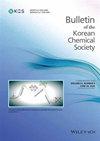提高锰催化5-羟甲基糠醛有氧氧化效率的策略
IF 2.2
4区 化学
引用次数: 0
摘要
5-羟甲基糠醛(HMF)的好氧氧化生成2,5-呋喃二羧酸(FDCA)是生物基塑料单体,是生物质再生的重要过程。本文通过引入氧空位,合成了具有相同形貌和相似表面积的不同氧化态的锰氧化物,并对其作为HMF氧化的多相催化剂进行了研究。由于金属基团的氧化态、催化剂的碱度和氧化物材料的氧迁移率在碱性条件下的协同作用,Mn2O3表现出了显著的催化效率。本文章由计算机程序翻译,如有差异,请以英文原文为准。

Strategies to increase catalytic efficiency of manganese-catalyzed aerobic oxidation of 5-hydroxymethylfurfural
The aerobic oxidation of 5-hydroxymethylfurfural (HMF) into 2,5-furandicarboxylic acid (FDCA), a bio-based plastic monomer, is an important process for the valorization of biomass. Here, manganese oxides of various oxidation states with identical morphologies and similar surface areas were synthesized by introducing oxygen vacancy sites, and they were investigated as heterogeneous catalysts for HMF oxidation. Mn2O3 exhibited a remarkable catalytic efficiency due to synergistic effect of the oxidation state of metal moieties, the basicity of the catalyst, and oxygen mobility of the oxide materials under basic condition.
求助全文
通过发布文献求助,成功后即可免费获取论文全文。
去求助
来源期刊

Bulletin of the Korean Chemical Society
Chemistry-General Chemistry
自引率
23.50%
发文量
182
期刊介绍:
The Bulletin of the Korean Chemical Society is an official research journal of the Korean Chemical Society. It was founded in 1980 and reaches out to the chemical community worldwide. It is strictly peer-reviewed and welcomes Accounts, Communications, Articles, and Notes written in English. The scope of the journal covers all major areas of chemistry: analytical chemistry, electrochemistry, industrial chemistry, inorganic chemistry, life-science chemistry, macromolecular chemistry, organic synthesis, non-synthetic organic chemistry, physical chemistry, and materials chemistry.
 求助内容:
求助内容: 应助结果提醒方式:
应助结果提醒方式:


